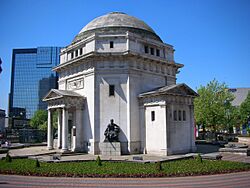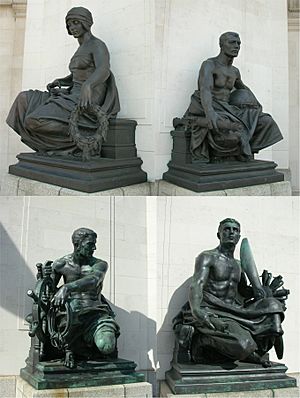Hall of Memory, Birmingham facts for kids
Quick facts for kids Hall of Memory |
|
|---|---|
 |
|
| General information | |
| Type | War memorial |
| Architectural style | Art Deco |
| Address | Centenary Square |
| Town or city | Birmingham |
| Country | United Kingdom |
| Elevation | Roof is 159.64 m (523.8 ft) ASL |
| Construction started | 12 June 1923 |
| Opened | 4 July 1925 |
| Cost | £60,000 |
| Height | 17 m (56 ft) |
| Technical details | |
| Material | Portland stone |
| Design and construction | |
| Architect |
|
| Main contractor |
|
|
Listed Building – Grade I
|
|
| Designated: | 27 October 2014 |
| Reference #: | 1244943 |
The Hall of Memory is a special building in Centenary Square, Birmingham, England. It was designed by S. N. Cooke and W. N. Twist. This important place remembers the 12,320 people from Birmingham who sadly died in World War I. It was built between 1922 and 1925.
Contents
What is the Hall of Memory?
The Hall of Memory is a war memorial. This means it's a monument built to honor soldiers and others who died in a war. It helps people remember their bravery and sacrifice.
Building the Memorial
The Hall of Memory was built on top of an old canal basin called Gibson's Arm. It was the first building in a new area that the city council bought. The council had big plans for this area. They wanted to build new offices, a home for the mayor, a public library, and a concert hall. However, these plans stopped when World War II began. Only a small part of one building, Baskerville House, was ever finished.
The memorial is made from a special kind of stone called Portland stone. This stone comes from the Isle of Portland in Dorset. The first stone was laid on June 12, 1923, by the Prince of Wales. The building officially opened on July 4, 1925. About 30,000 people came to see it open!
The building cost £60,000 to build. This money was raised through donations from the public.

Statues and Art
Around the outside of the Hall of Memory, there are four large statues. These were created by a local artist named Albert Toft. Each statue represents a different part of the armed forces:
Inside the hall, you can see three carved pictures called bas-relief plaques. These were made by William Bloye. Each picture shows a different part of the war experience:
- Call: This shows people leaving for war.
- Front Line: This shows soldiers fighting.
- Return: This shows wounded soldiers coming home.
These carvings have important words written on them:
OF 150,000 WHO ANSWERED THE CALL TO ARMS 12,320 FELL: 35,000 CAME HOME DISABLED
AT THE GOING DOWN OF THE SUN AND IN THE MORNING WE WILL REMEMBER THEM
SEE TO IT THAT THEY SHALL NOT HAVE SUFFERED AND DIED IN VAIN +*+
There is also a special book called a roll of honour inside. It lists the names of those who died and has illustrations by Sidney Meteyard.
Protecting the Memorial
The Hall of Memory is a very important building. On October 27, 2014, it was given a special protection status. It was upgraded to a Grade I listed building. This means it's considered a building of exceptional historical interest and is protected by law.
Peace Garden Connection
During World War II, Birmingham was bombed by German planes. This was called the Birmingham Blitz. On December 11, 1940, a nearby church, St Thomas' Church, was mostly destroyed. Only its tower and front entrance were left. The church was never rebuilt.
Next to the Hall of Memory, there used to be a row of columns called a colonnade. This was also a memorial from World War I. In 1989, when Centenary Square was being built, this colonnade was moved to the site of the old St Thomas' Church.

In 1995, the gardens around the colonnade were redesigned. They became the St Thomas' Peace Garden. This was done to mark 50 years since the end of World War II. It is now a place to remember peace and all those who have died in conflicts.


